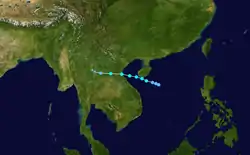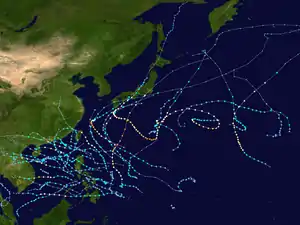Tropical Storm Talas (2017)
Severe Tropical Storm Talas was a tropical cyclone that impacted Vietnam during mid July 2017. Talas was first tracked as a tropical disturbance over in the South China Sea on July 13, and was upgraded to a tropical depression during the next day. The depression intensified into the fourth named storm of the 2017 Pacific typhoon season during July 15. Before making landfall in Vietnam, Talas reached its peak intensity as a severe tropical storm during July 16. Talas weakened to an area of low pressure on July 17 inland.
| Severe tropical storm (JMA scale) | |
|---|---|
| Tropical storm (SSHWS) | |
 Severe Tropical Storm Talas near peak intensity and approaching Vietnam on July 16 | |
| Formed | July 14, 2017 |
| Dissipated | July 17, 2017 |
| Highest winds | 10-minute sustained: 95 km/h (60 mph) 1-minute sustained: 95 km/h (60 mph) |
| Lowest pressure | 985 hPa (mbar); 29.09 inHg |
| Fatalities | 14 total |
| Damage | $117.8 million (2017 USD) |
| Areas affected | Vietnam, South China, Laos, Thailand, Myanmar |
| Part of the 2017 Pacific typhoon season | |
Throughout Vietnam, the storm killed 14 people and damaged around 2,700 houses. Rough seas sunk about 50 boats. Nearly 50,000 ha (123,600 acres) of vegetable fields, about 800 ha (1,980 acres) of aquaculture, and 47,600 ha (118,000 acres) of rice and subsidiary crops were damaged. Damage was estimated at 2.52 trillion₫ (US$109 million).[1]
Meteorological history

During July 13, the Joint Typhoon Warning Center (JTWC) began to monitor a tropical disturbance located about 648 km (403 mi) to the southeast of Hanoi, Vietnam.[2] By the next day, at around 06:00 UTC, the Japan Meteorological Agency (JMA) classified the system as a weak tropical depression, as it started to move slowly towards the northwest.[3] Six hours later, the JMA began issuing advisories, noting that the system was producing 10-minute sustained winds of at least 55 km/h (35 mph).[4] The JTWC issued a Tropical Cyclone Formation Alert at 02:30 UTC on July 15 after satellite imagery depicted deep convection wrapping into its developing low-level circulation center.[5] With the system continuing to develop, the JMA upgraded it to a tropical storm, assigning it the name Talas.[6] As convective banding improved, the JTWC upgraded the disturbance to a tropical depression by midday on July 15.[7][8] Several hours later, the JTWC further upgraded Talas to a tropical storm after recording Dvorak estimates of T2.5, indicating 1-minute sustained winds of 65 km/h (40 mph).[9]
On July 16, Talas gradually intensified as it became better organized in response to being located in a favorable environment, consisting of low to moderate northeasterly vertical wind shear as well as good outflow to the south.[10] At 09:00 UTC, the JMA upgraded Talas into a severe tropical storm after the storm attained 10-minute sustained winds of 95 km/h (60 mph) and a minimum barometric pressure of 985 hPa (29.23 inHg); this constituted its peak intensity.[11] At the same time, the JTWC also recorded 1-minute sustained peak winds of 95 km/h (60 mph).[12] Shortly thereafter, Talas began to weaken due to land interaction and the JMA soon downgraded the system back to a tropical storm.[13] Around 18:00 UTC, Talas made landfall in Central Vietnam, near the city of Vinh.[14] Three hours later, the JTWC issued their final advisory on Talas as it continued to degrade while progressing inland.[15] The JMA soon followed suit with their final advisory at 09:00 UTC on July 17 while the weakening Talas was located over the northern portion of Laos.[16]
Preparations and impact
Vietnam
Talas made landfall near Vinh at around 18:00 UTC on July 16 as a moderate tropical storm.[14] According to the Central Steering Committee for Natural Disaster Prevention and Rescue, more than 2,700 homes were damaged in Nghe An Province. The Vietnam's National Center for Hydro-Meteorological Forecasting recorded wind gusts up to 100 km/h (62 mph) with wind damage being reported in Nghe An, Thanh Hóa and Ha Tinh provinces.[14] Over 400 mm (16 in) of rain fell in the central and northern parts of the country in the two days following up to landfall, while the capital, Hanoi, received 100 mm (4 in).[17] The storm sank a coal ship late on July 16; only three of the people on board were rescued while another ten remained missing.[18] In the Quảng Bình Province, fishing boats were washed ashore by waves as high as 5 m (16.4 ft); there, seven people were injured.[19] During July 17, flooded streets and disrupted train services stranded more than 4,000 passengers in the capital. Railway services from Hanoi to Vinh were canceled while trains from Hanoi to Saigon were delayed by five to seven hours.[19]
Overall, in Vietnam, the storm left 14 people dead and damaged around 2,700 houses.[20] About 50 boats sank. Around 50,000 ha (123,555 acres) of vegetable fields,[17] about 801 ha (1,980 acres) of aquaculture farms, and 47,632 ha (117,700 acres) of rice and subsidiary crops were damaged.[21] Damages in Nghe An were reported to reach up to 993 billion₫ (US$43.7 million).[22] Total damage in Vietnam reached 1.6 trillion₫ (US$70.4 million).[23]
Hainan
During July 22, China's National Observatory issued a "blue alert" to Hainan province and the Beibu Gulf. About 22,901 fishing boats were moved while 39,425 people working at sea farms evacuated to Guangdong province.[24] Winds of 62–74 km/h (39–46 mph) were recorded over in some places, especially in areas around the Lingshui Li Autonomous County, as the storm neared the coast.[25] Southern portions of the province received rainfall of 3–6 in (7.6–15.2 cm). About 49 tourists were stranded from an island off the coast of Guandong.[26] Total economic losses in Hainan Province reached CNY 24 million (US$3.5 million).[27] In total, damage by Talas in China reached CNY 60 million (US$8.8 million).[28]
See also
References
- http://phongchongthientai.mard.gov.vn/FileUpload/2019-08/u4fxaVGl-kKJ8YgF2017-00.%20THIET%20HAI%20NAM%202017_tinh,%20tp_ngay%2031.12.2017.pdf
- https://www.webcitation.org/6rvBL5mvd?url=http://gwydir.demon.co.uk/advisories/ABPW10-PGTW_201707130600.htm
- https://www.webcitation.org/6rzobvGVE?url=http://gwydir.demon.co.uk/advisories/WWJP25-RJTD_201707140600.htm
- "RSMC Tropical Cyclone Advisory TD". Japan Meteorological Agency. July 14, 2017. Archived from the original on July 16, 2017.CS1 maint: bot: original URL status unknown (link)
- https://www.webcitation.org/6rzpVfmZI?url=http://gwydir.demon.co.uk/advisories/WTPN21-PGTW_201707150230.htm
- "RSMC Tropical Cyclone Advisory TS 1704 TALAS (1704) UPGRADED FROM TD". Japan Meteorological Agency. July 15, 2017. Archived from the original on July 16, 2017.CS1 maint: bot: original URL status unknown (link)
- "Tropical Depression 06W (Talas) Warning Nr 001". Joint Typhoon Warning Center. July 15, 2017. Archived from the original on July 16, 2017.CS1 maint: bot: original URL status unknown (link)
- "Prognostic Reasoning for Tropical Depression 06W (Talas) Warning Nr 01". Joint Typhoon Warning Center. July 15, 2017. Archived from the original on July 16, 2017.CS1 maint: bot: original URL status unknown (link)
- "Prognostic Reasoning for Tropical Storm 06W (Talas) Warning Nr 02". Joint Typhoon Warning Center. July 15, 2017. Archived from the original on July 16, 2017.CS1 maint: bot: original URL status unknown (link)
- "Prognostic Reasoning for Tropical Storm 06W (Talas) Warning Nr 03". Joint Typhoon Warning Center. July 16, 2017. Archived from the original on July 16, 2017.CS1 maint: bot: original URL status unknown (link)
- "RSMC Tropical Cyclone Advisory STS 1704 TALAS (1704) UPGRADED FROM TS". Japan Meteorological Agency. July 16, 2017. Archived from the original on July 17, 2017.CS1 maint: bot: original URL status unknown (link)
- "Prognostic Reasoning for Tropical Storm 06W (Talas) Warning Nr 04". Joint Typhoon Warning Center. July 16, 2017. Archived from the original on July 16, 2017.CS1 maint: bot: original URL status unknown (link)
- "RSMC Tropical Cyclone Advisory TS 1704 TALAS (1704) DOWNGRADED FROM STS". Japan Meteorological Agency. July 16, 2017. Archived from the original on July 17, 2017.CS1 maint: bot: original URL status unknown (link)
- "Tropical Storm Talas (06W)". Rish Management Solutions, Inc. July 17, 2017.
- "Tropical Storm 06W (Talas) Warning Nr 006". Joint Typhoon Warning Center. July 16, 2017. Archived from the original on July 17, 2017.CS1 maint: bot: original URL status unknown (link)
- "RSMC Tropical Cyclone Advisory TD 1704 TALAS (1704) DOWNGRADED FROM TS". Japan Meteorological Agency. July 17, 2017. Archived from the original on July 17, 2017.CS1 maint: bot: original URL status unknown (link)
- "A tropical storm has left four dead, five missing in Vietnam". The China Post. July 19, 2017. Retrieved July 19, 2017.
- "Tropical Storm Talas hits Vietnam, leaves one dead". The Gulf Today. July 17, 2017. Archived from the original on July 17, 2017. Retrieved July 20, 2017.
- "Storm Talas leaves path of destruction in Vietnam's central provinces". Nhân Dân. July 17, 2017.
- "Storm Talas kills 14 in Vietnam, destroys homes". The Straits Times. 19 July 2017. Retrieved 19 July 2017.
- "One more body found from missing ship". Viet Nam News. July 20, 2017.
- "Storm-ravaged Vietnamese province closes beaches with Sonca bearing down". VN Express. July 25, 2017.
- "Tổng cục Thống kê". www.gso.gov.vn.
- "Tropical Storm "Talas" makes landfall over central Vietnam". The Watchers. July 17, 2017.
- "Typhoon Talas to hit south China, 20,000 boats moored at bay". Xinhua. July 16, 2017.
- "Stranded Tourists Rescued From China Island as Tropical Storm Talas Approaches". The Weather Channel. July 16, 2017.
- "海南部分地区遭受台风灾害". 中华人民共和国民政部. July 17, 2017. Archived from the original on December 4, 2017. Retrieved December 3, 2017.
- http://www.typhooncommittee.org/12IWS/docs/Members/China20171026_final.pdf
External links
| Wikimedia Commons has media related to Severe Tropical Storm Talas (2017). |
- JMA General Information of Severe Tropical Storm Talas (1704) from Digital Typhoon
- JMA Best Track Data of Severe Tropical Storm Talas (1704) (in Japanese)
- 06W.TALAS from the U.S. Naval Research Laboratory
